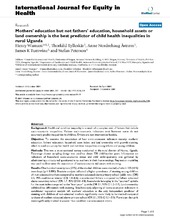| dc.contributor.author | Wamani, Henry | en_US |
| dc.contributor.author | Tylleskär, Thorkild | en_US |
| dc.contributor.author | Åstrøm, Anne Nordrehaug | en_US |
| dc.contributor.author | Tumwine, James K. | en_US |
| dc.contributor.author | Peterson, Stefan | en_US |
| dc.date.accessioned | 2014-09-05T12:40:06Z | |
| dc.date.available | 2014-09-05T12:40:06Z | |
| dc.date.issued | 2004-10-13 | eng |
| dc.identifier.issn | 1475-9276 | |
| dc.identifier.uri | https://hdl.handle.net/1956/8425 | |
| dc.description.abstract | Background: Health and nutrition inequality is a result of a complex web of factors that include socio-economic inequalities. Various socio-economic indicators exist however some do not accurately predict inequalities in children. Others are not intervention feasible. Objective: To examine the association of four socio-economic indicators namely: mothers' education, fathers' education, household asset index, and land ownership with growth stunting, which is used as a proxy for health and nutrition inequalities among infants and young children. Methods: This was a cross-sectional survey conducted in the rural district of Hoima, Uganda. Two-stage cluster sampling design was used to obtain 720 child/mother pairs. Information on indicators of household socio-economic status and child anthropometry was gathered by administering a structured questionnaire to mothers in their home settings. Regression modelling was used to determine the association of socio-economic indicators with stunting. Results: One hundred seventy two (25%) of the studied children were stunted, of which 105 (61%) were boys (p < 0.001). Bivariate analysis indicated a higher prevalence of stunting among children of: non-educated mothers compared to mothers educated above primary school (odds ratio (OR) 2.5, 95% confidence interval (CI) 1.4–4.4); non-educated fathers compared to fathers educated above secondary school (OR 1.7, 95% CI 0.8–3.5); households belonging in the "poorest" quintile for the asset index compared to the "least poor" quintile (OR 2.1, 95% CI 1.2–3.7); Land ownership exhibited no differentials with stunting. Simultaneously adjusting all socio-economic indicators in conditional regression analysis left mothers' education as the only independent predictor of stunting with children of non-educated mothers significantly more likely to be stunted compared to those of mothers educated above primary school (OR 2.1, 95% CI 1.1–3.9). More boys than girls were significantly stunted in poorer than wealthier socio-economic strata. Conclusions: Of four socio-economic indicators, mothers' education is the best predictor for health and nutrition inequalities among infants and young children in rural Uganda. This suggests a need for appropriate formal education of the girl child aimed at promoting child health and nutrition. The finding that boys are adversely affected by poverty more than their female counterparts corroborates evidence from previous studies. | en_US |
| dc.language.iso | eng | eng |
| dc.publisher | BioMed Central | eng |
| dc.rights | Attribution CC BY | eng |
| dc.rights.uri | http://creativecommons.org/licenses/by/2.0/ | eng |
| dc.title | Mothers' education but not fathers' education, household assets or land ownership is the best predictor of child health inequalities in rural Uganda | en_US |
| dc.type | Peer reviewed | |
| dc.type | Journal article | |
| dc.date.updated | 2013-08-28T17:17:58Z | |
| dc.description.version | publishedVersion | en_US |
| dc.rights.holder | Copyright 2004 Wamani et al; licensee BioMed Central Ltd. | |
| dc.rights.holder | Henry Wamani et al.; licensee BioMed Central Ltd. | |
| dc.source.articlenumber | 9 | |
| dc.identifier.doi | https://doi.org/10.1186/1475-9276-3-9 | |
| dc.identifier.cristin | 421888 | |
| dc.source.journal | International Journal for Equity in Health | |
| dc.source.40 | 3 | |

